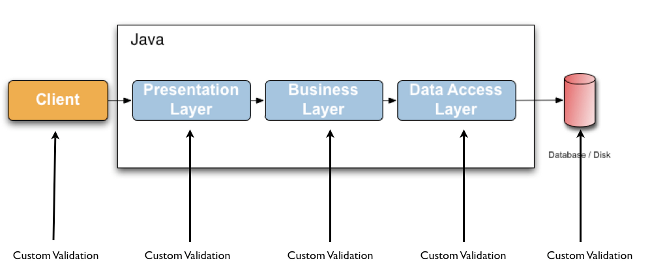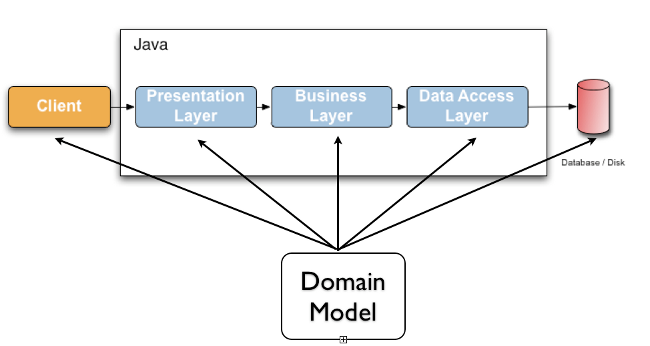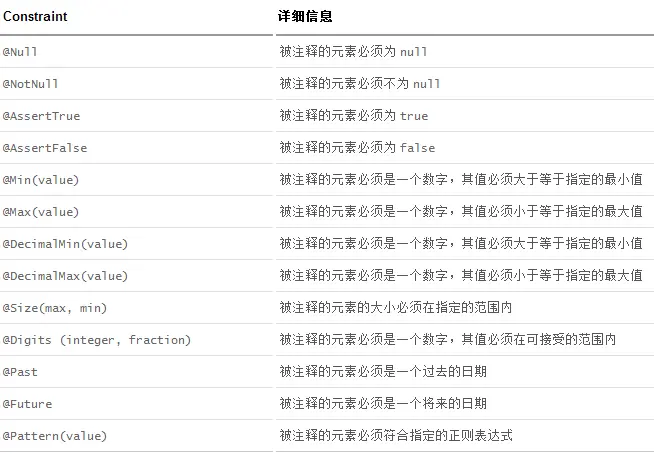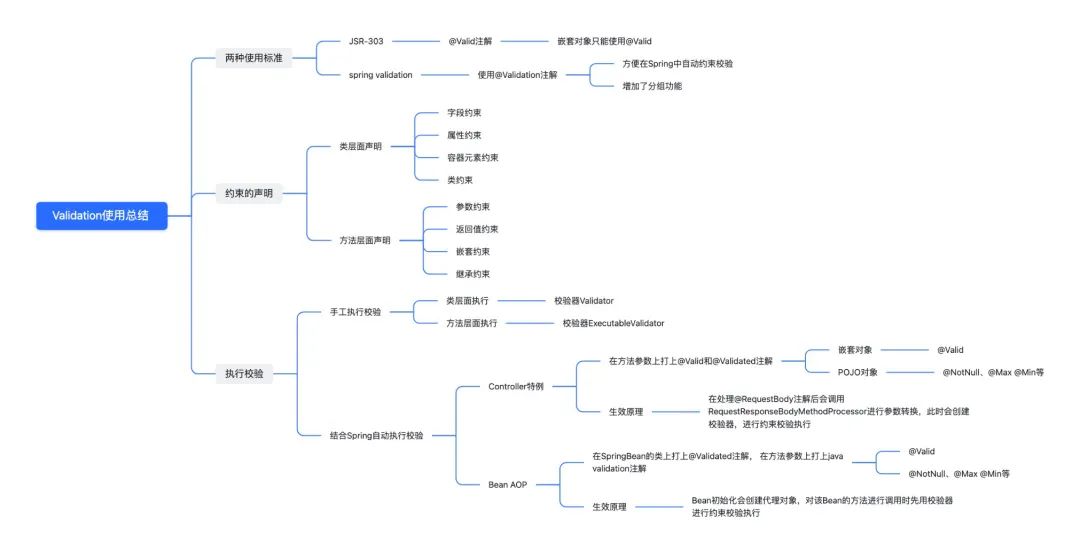如何正确使用 Bean Validation 进行数据校验
一、背景
在前后端开发过程中,数据校验是一项必须且常见的事,从展示层、业务逻辑层到持久层几乎每层都需要数据校验。如果在每一层中手工实现验证逻辑,既耗时又容易出错。

为了避免重复这些验证,通常的做法是将验证逻辑直接捆绑到领域模型中,通过元数据(默认是注解)去描述模型, 生成校验代码,从而使校验从业务逻辑中剥离,提升开发效率,使开发者更专注业务逻辑本身。

在 Spring 中,目前支持两种不同的验证方法:Spring Validation 和 JSR-303 Bean Validation,即?@Validated(org . springframework.validation.annotation.Validated)和 @Valid(javax.validation.Valid)。两者都可以通过定义模型的约束来进行数据校验,虽然两者使用类似,在很多场景下也可以相互替换,但实际上却完全不同,这些差别长久以来对我们日常使用产生了较大疑惑,本文主要梳理其中的差别、介绍 Validation 的使用及其实现原理,帮助大家在实践过程中更好使用 Validation 功能。
二、Bean Validation简介
什么是JSR?
JSR 是 Java Specification Requests 的缩写,意思是 Java 规范提案。是指向 JCP(Java Community Process) 提出新增一个标准化技术规范的正式请求,以向 Java 平台增添新的 API 和服务。JSR 已成为 Java 界的一个重要标准。
JSR-303定义的是什么标准?
JSR-303 是用于 Bean Validation 的 Java API 规范,该规范是 Jakarta EE and JavaSE 的一部分,Hibernate Validator 是 Bean Validation 的参考实现。Hibernate Validator 提供了 JSR 303 规范中所有内置 Constraint 的实现,除此之外还有一些附加的 Constraint。(最新的为 JSR-380 为 Bean Validation 3.0)

常用的校验注解补充:
@NotBlank 检查约束字符串是不是 Null 还有被 Trim 的长度是否大于,只对字符串,且会去掉前后空格。
@NotEmpty 检查约束元素是否为 Null 或者是 Empty。
@Length 被检查的字符串长度是否在指定的范围内。
@Email 验证是否是邮件地址,如果为 Null,不进行验证,算通过验证。
@Range 数值返回校验。
@IdentityCardNumber 校验身份证信息。
@UniqueElements 集合唯一性校验。
@URL 验证是否是一个 URL 地址。
Spring Validation的产生背景
上文提到 Spring 支持两种不同的验证方法:Spring Validation 和 JSR-303 Bean Validation(下文使用@Validated和@Valid替代)。
为什么会同时存在两种方式?
Spring 增加 @Validated 是为了支持分组校验,即同一个对象在不同的场景下使用不同的校验形式。比如有两个步骤用于提交用户资料,后端复用的是同一个对象,第一步验证姓名,电子邮件等字段,然后在后续步骤中的其他字段中。这时候分组校验就会发挥作用。
为什么不合入到 JSR-303 中?
之所以没有将它添加到 @Valid 注释中,是因为它是使用 Java 社区过程(JSR-303)标准化的,这需要时间,而 Spring 开发者想让人们更快地使用这个功能。
@Validated 的内置自动化校验
Spring 增加 @Validated 还有另一层原因,Bean Validation 的标准做法是在程序中手工调用 Validator 或者 ExecutableValidator 进行校验,为了实现自动化,通常通过 AOP、代理等方法拦截技术来调用。而 @Validated 注解就是为了配合 Spring 进行 AOP 拦截,从而实现 Bean Validation 的自动化执行。
@Validated 和 @Valid 的区别
@Valid 是 JSR 标准 API,@Validated 扩展了 @Valid 支持分组校验且能作为 SpringBean 的 AOP 注解,在 SpringBean 初始化时实现方法层面的自动校验。最终还是使用了 JSR API 进行约束校验。
三、Bean Validation的使用
引入POM
// 正常应该引入hibernate-validator,是JSR的参考实现
<dependency>
<groupId>org.hibernate.validator</groupId>
<artifactId>hibernate-validator</artifactId>
</dependency>
// Spring在stark中集成了,所以hibernate-validator可以不用引入
<dependency>
<groupId>org.springframework.boot</groupId>
<artifactId>spring-boot-starter-validation</artifactId>
</dependency>
Bean层面校验
- 变量层面约束
public class EntryApplicationInfoCmd {
/**
* 用户ID
*/
@NotNull(message = "用户ID不为空")
private Long userId;
/**
* 证件类型
*/
@NotEmpty(message = "证件类型不为空")
private String certType;
}
- 属性层面约束
主要为了限制 Setter 方法的只读属性。属性的 Getter 方法打注释,而不是 Setter。
public class EntryApplicationInfoCmd {
public EntryApplicationInfoCmd(Long userId, String certType) {
this.userId = userId;
this.certType = certType;
}
/**
* 用户ID
*/
private Long userId;
/**
* 证件类型
*/
private String certType;
@NotNull
public String getUserId() {
return userId;
}
@NotEmpty
public String getCertType() {
return userId;
}
}
- 容器元素约束
public class EntryApplicationInfoCmd {
...
List<@NotEmpty Long> categoryList;
}
- 类层面约束
@CategoryBrandNotEmptyRecord 是自定义类层面的约束,也可以约束在构造函数上。
@CategoryBrandNotEmptyRecord
public class EntryApplicationInfoCmd {
/**
* 用户ID
*/
@NotNull(message = "用户ID不为空")
private Long userId;
List<@NotEmpty Long> categoryList;
}
- 嵌套约束
嵌套对象需要额外使用 @Valid 进行标注(@Validate 不支持,为什么?请看产生的背景)。
public class EntryApplicationInfoCmd {
/**
* 主营品牌
*/
@Valid
@NotNull
private MainBrandImagesCmd mainBrandImage;
}
public class MainBrandImagesCmd {
/**
* 品牌名称
*/
@NotEmpty
private String brandName;;
}
- 手工验证Bean约束
// 获取校验器
ValidatorFactory factory = Validation.buildDefaultValidatorFactory();
Validator validator = factory.getValidator();
// 进行bean层面校验
Set<ConstraintViolation<User>> violations = validator.validate(EntryApplicationInfoCmd);
// 打印校验信息
for (ConstraintViolation<User> violation : violations) {
log.error(violation.getMessage());
}
方法层面校验
- 函数参数约束
public class MerchantMainApplyQueryService {
MainApplyDetailResp detail(@NotNull(message = "申请单号不能为空") Long id) {
...
}
}
- 函数返回值约束
public class MerchantMainApplyQueryService {
@NotNull
@Size(min = 1)
public List<@NotNull MainApplyStandDepositResp> getStanderNewDeposit(Long id) {
//...
}
}
- 嵌套约束
嵌套对象需要额外使用 @Valid 进行标注(@Validate 不支持)。
public class MerchantMainApplyQueryService {
public NewEntryBrandRuleCheckApiResp brandRuleCheck(@Valid @NotNull NewEntryBrandRuleCheckRequest request) {
...
}
}
public class NewEntryBrandRuleCheckRequest {
@NotNull(message = "一级类目不能为空")
private Long level1CategoryId;
}
- 在继承中方法约束
Validation 的设计需要遵循里氏替换原则,无论何时使用类型 T,也可以使用 T 的子类型 S,而不改变程序的行为。即子类不能增加约束也不能减弱约束。
子类方法参数的约束与父类行为不一致(++错误例子++):
// 继承的方法参数约束不能改变,否则会导致父类子类行为不一致
public interface Vehicle {
void drive(@Max(75) int speedInMph);
}
public class Car implements Vehicle {
@Override
public void drive(@Max(55) int speedInMph) {
//...
}
}
方法的返回值可以增加约束(++正确例子++):
// 继承的方法返回值可以增加约束
public interface Vehicle {
@NotNull
List<Person> getPassengers();
}
public class Car implements Vehicle {
@Override
@Size(min = 1)
public List<Person> getPassengers() {
//...
return null;
}
}
- 手工验证方法约束
方法层面校验使用的是 ExecutableValidator。
// 获取校验器
ValidatorFactory factory = Validation.buildDefaultValidatorFactory();
Validator executableValidator = factory.getValidator().forExecutables();
// 进行方法层面校验
MerchantMainApplyQueryService service = getService();
Method method = MerchantMainApplyQueryService.class.getMethod( "getStanderNewDeposit", int.class );
Object[] parameterValues = { 80 };
Set<ConstraintViolation<Car>> violations = executableValidator.validateParameters(
service,
method,
parameterValues
);
// 打印校验信息
for (ConstraintViolation<User> violation : violations) {
log.error(violation.getMessage());
}
分组校验
不同场景复用一个 Model,采用不一样的校验方式。
public class NewEntryMainApplyRequest {
@NotNull(message = "一级类目不能为空")
private Long level1CategoryId;
@NotNull(message = "申请单ID不能为空", group = UpdateMerchantMainApplyCmd.class)
private Long applyId;
@NotEmpty(message = "审批人不能为空", group = AddMerchantMainApplyCmd.class)
private String operator;
}
// 校验分组UpdateMerchantMainApplyCmd.class
NewEntryMainApplyRequest request1 = new NewEntryMainApplyRequest( 29, null, "aaa");
Set<ConstraintViolation<NewEntryMainApplyRequest>> constraintViolations = validator.validate( request1, UpdateMerchantMainApplyCmd.class );
assertEquals("申请单ID不能为空", constraintViolations.iterator().next().getMessage());
// 校验分组AddMerchantMainApplyCmd.class
NewEntryMainApplyRequest request2 = new NewEntryMainApplyRequest( 29, "12345", "");
Set<ConstraintViolation<NewEntryMainApplyRequest>> constraintViolations = validator.validate( request2, AddMerchantMainApplyCmd.class );
assertEquals("审批人不能为空", constraintViolations.iterator().next().getMessage());
自定义校验
自定义注解:
@Target({ElementType.METHOD, ElementType.FIELD, ElementType.PARAMETER})
@Retention(RetentionPolicy.RUNTIME)
@Constraint(validatedBy = MyConstraintValidator.class)
public @interface MyConstraint {
String message();
Class<?>[] groups() default {};
Class<? extends Payload>[] payload() default {};
}
自定义校验器:
public class MyConstraintValidator implements ConstraintValidator<MyConstraint, Object> {
@Override
public void initialize(MyConstraint constraintAnnotation) {
}
@Override
public isValid isValid(Object value, ConstraintValidatorContext context) {
String name = (String)value;
if("xxxx".equals(name)) {
return true;
}
return false;
}
}
使用自定义约束:
public class Test {
@MyConstraint(message = "test")
String name;
}
四、Bean Validation自动执行以及原理
上述 2.6 和 3.5 分别实现了 Bean 和 Method 层面的约束校验,但是每次都主动调用比较繁琐,因此 Spring 在 @RestController 的 @RequestBody 注解中内置了一些自动化校验以及在 Bean 初始化中集成了 AOP 来简化编码。
Validation的常见误解
最常见的应该就是在 RestController 中,校验 @RequestBody 指定参数的约束,使用 @Validated 或者 @Valid(++该场景下两者等价++)进行约束校验,以至于大部分人理解的 Validation 只要打个注解就可以生效,实际上这只是一种特例。很多人在使用过程中经常遇到约束校验不生效。
- 约束校验生效
Spring-mvc 中在 @RequestBody 后面加 @Validated、@Valid 约束即可生效。
@RestController
@RequestMapping("/biz/merchant/enter")
public class MerchantEnterController {
@PostMapping("/application")
// 使用@Validated
public HttpMessageResult addOrUpdateV1(@RequestBody @Validated MerchantEnterApplicationReq req){
...
}
// 使用@Valid
@PostMapping("/application2")
public HttpMessageResult addOrUpdate2(@RequestBody @Valid MerchantEnterApplicationReq req){
...
}
}
- 约束校验不生效
然而下面这个约束其实是不生效的,想要生效得在 MerchantEntryServiceImpl 类目加上 @Validated 注解。
// @Validated 不加不生效
@Service
public class MerchantEntryService {
public Boolean applicationAddOrUpdate(@Validated MerchantEnterApplicationReq req) {
...
}
public Boolean applicationAddOrUpdate2(@Valid MerchantEnterApplicationReq req) {
...
}
}
那么究竟为什么会出现这种情况呢,这就需要对 Spring Validation 的注解执行原理有一定的了解。
Controller自动执行约束校验原理
在 Spring-mvc 中,有很多拦截器对 Http 请求的出入参进行解析和转换,Validation 解析和执行也是类似,其中 RequestResponseBodyMethodProcessor 是用于解析 @RequestBody 标注的参数以及处理 @ResponseBody 标注方法的返回值的。
public class RequestResponseBodyMethodProcessor extends AbstractMessageConverterMethodProcessor {
@Override
public boolean supportsParameter(MethodParameter parameter) {
return parameter.hasParameterAnnotation(RequestBody.class);
}
// 类上或者方法上标注了@ResponseBody注解都行
@Override
public boolean supportsReturnType(MethodParameter returnType) {
return (AnnotatedElementUtils.hasAnnotation(returnType.getContainingClass(), ResponseBody.class) || returnType.hasMethodAnnotation(ResponseBody.class));
}
// 这是处理入参封装校验的入口
@Override
public Object resolveArgument(MethodParameter parameter, @Nullable ModelAndViewContainer mavContainer,
NativeWebRequest webRequest, @Nullable WebDataBinderFactory binderFactory) throws Exception {
parameter = parameter.nestedIfOptional();
// 获取请求的参数对象
Object arg = readWithMessageConverters(webRequest, parameter, parameter.getNestedGenericParameterType());
// 获取参数名称
String name = Conventions.getVariableNameForParameter(parameter);
// 只有存在binderFactory才会去完成自动的绑定、校验~
if (binderFactory != null) {
WebDataBinder binder = binderFactory.createBinder(webRequest, arg, name);
if (arg != null) {
// 这里完成数据绑定+数据校验~~~~~(绑定的错误和校验的错误都会放进Errors里)
validateIfApplicable(binder, parameter);
// 若有错误消息hasErrors(),并且仅跟着的一个参数不是Errors类型,Spring MVC会主动给你抛出MethodArgumentNotValidException异常
if (binder.getBindingResult().hasErrors() && isBindExceptionRequired(binder, parameter)) {
throw new MethodArgumentNotValidException(parameter, binder.getBindingResult());
}
}
// 把错误消息放进去 证明已经校验出错误了~~~
// 后续逻辑会判断MODEL_KEY_PREFIX这个key的~~~~
if (mavContainer != null) {
mavContainer.addAttribute(BindingResult.MODEL_KEY_PREFIX + name, binder.getBindingResult());
}
}
return adaptArgumentIfNecessary(arg, parameter);
}
...
}
约束的校验逻辑是在 RequestResponseBodyMethodProcessor.validateIfApplicable 实现的,这里同时兼容了 @Validated 和 @Valid,所以该场景下两者是等价的。
// 校验,如果合适的话。使用WebDataBinder,失败信息最终也都是放在它身上~
// 入参:MethodParameter parameter
protected void validateIfApplicable(WebDataBinder binder, MethodParameter parameter) {
// 拿到标注在此参数上的所有注解们(比如此处有@Valid和@RequestBody两个注解)
Annotation[] annotations = parameter.getParameterAnnotations();
for (Annotation ann : annotations) {
// 先看看有木有@Validated
Validated validatedAnn = AnnotationUtils.getAnnotation(ann, Validated.class);
// 这个里的判断是关键:可以看到标注了@Validated注解 或者注解名是以Valid打头的 都会有效哦
//注意:这里可没说必须是@Valid注解。实际上你自定义注解,名称只要一Valid开头都成~~~~~
if (validatedAnn != null || ann.annotationType().getSimpleName().startsWith("Valid")) {
// 拿到分组group后,调用binder的validate()进行校验~~~~
// 可以看到:拿到一个合适的注解后,立马就break了~~~
// 所以若你两个主机都标注@Validated和@Valid,效果是一样滴~
Object hints = (validatedAnn != null ? validatedAnn.value() : AnnotationUtils.getValue(ann));
Object[] validationHints = (hints instanceof Object[] ? (Object[]) hints : new Object[] {hints});
binder.validate(validationHints);
break;
}
}
binder.validate() 的实现中使用的 org.springframework.validation.Validator 的接口,该接口的实现为 SpringValidatorAdapter。
public void validate(Object... validationHints) {
Object target = getTarget();
Assert.state(target != null, "No target to validate");
BindingResult bindingResult = getBindingResult();
for (Validator validator : getValidators()) {
// 使用的org.springframework.validation.Validator,调用SpringValidatorAdapter.validate
if (!ObjectUtils.isEmpty(validationHints) && validator instanceof SmartValidator) {
((SmartValidator) validator).validate(target, bindingResult, validationHints);
}
else if (validator != null) {
validator.validate(target, bindingResult);
}
}
}
在 ValidatorAdapter.validate 实现中,最终调用了 javax.validation.Validator.validate,也就是说最终是调用 JSR 实现,@Validate 只是外层的包装,在这个包装中扩展的分组功能。
public class SpringValidatorAdapter {
...
private javax.validation.Validator targetValidator;
@Override
public void validate(Object target, Errors errors) {
if (this.targetValidator != null) {
processConstraintViolations(
// 最终是调用JSR实现
this.targetValidator.validate(target), errors));
}
}
}
++targetValidator.validate 就是 javax.validation.Validator.validate 上述 2.6 Bean 层面手工验证一致。++
Service自动执行约束校验原理
非Controller的@RequestBody注解,自动执行约束校验,是通过 MethodValidationPostProcessor 实现的,该类继承。
BeanPostProcessor, 在 Spring Bean 初始化过程中读取 @Validated 注解创建 AOP 代理(实现方式与 @Async 基本一致)。该类开头文档注解(++JSR 生效必须类层面上打上 @Spring Validated 注解++)。
/**
* <p>Target classes with such annotated methods need to be annotated with Spring's
* {@link Validated} annotation at the type level, for their methods to be searched for
* inline constraint annotations. Validation groups can be specified through {@code @Validated}
* as well. By default, JSR-303 will validate against its default group only.
*/
public class MethodValidationPostProcessor extends AbstractBeanFactoryAwareAdvisingPostProcessor
implements InitializingBean {
private Class<? extends Annotation> validatedAnnotationType = Validated.class;
@Nullable
private Validator validator;
.....
/**
* 设置Validator
* Set the JSR-303 Validator to delegate to for validating methods.
* <p>Default is the default ValidatorFactory's default Validator.
*/
public void setValidator(Validator validator) {
// Unwrap to the native Validator with forExecutables support
if (validator instanceof LocalValidatorFactoryBean) {
this.validator = ((LocalValidatorFactoryBean) validator).getValidator();
}
else if (validator instanceof SpringValidatorAdapter) {
this.validator = validator.unwrap(Validator.class);
}
else {
this.validator = validator;
}
}
/**
* Create AOP advice for method validation purposes, to be applied
* with a pointcut for the specified 'validated' annotation.
* @param validator the JSR-303 Validator to delegate to
* @return the interceptor to use (typically, but not necessarily,
* a {@link MethodValidationInterceptor} or subclass thereof)
* @since 4.2
*/
protected Advice createMethodValidationAdvice(@Nullable Validator validator) {
// 创建了方法调用时的拦截器
return (validator != null ? new MethodValidationInterceptor(validator) : new MethodValidationInterceptor());
}
}
真正执行方法调用时,会走到 MethodValidationInterceptor.invoke,进行约束校验。
public class MethodValidationInterceptor implements MethodInterceptor {
@Override
public Object invoke(MethodInvocation invocation) throws Throwable {
// Avoid Validator invocation on FactoryBean.getObjectType/isSingleton
if (isFactoryBeanMetadataMethod(invocation.getMethod())) {
return invocation.proceed();
}
// Standard Bean Validation 1.1 API
ExecutableValidator execVal = this.validator.forExecutables();
...
try {
// 执行约束校验
result = execVal.validateParameters(
invocation.getThis(), methodToValidate, invocation.getArguments(), groups);
}
catch (IllegalArgumentException ex) {
// Probably a generic type mismatch between interface and impl as reported in SPR-12237 / HV-1011
// Let's try to find the bridged method on the implementation class...
methodToValidate = BridgeMethodResolver.findBridgedMethod(
ClassUtils.getMostSpecificMethod(invocation.getMethod(), invocation.getThis().getClass()));
result = execVal.validateParameters(
invocation.getThis(), methodToValidate, invocation.getArguments(), groups);
}
...
return returnValue;
}
}
execVal.validateParameters 就是 javax.validation.executable.ExecutableValidator.validateParameters 与上述 3.5 方法层面手工验证一致。
五、总结

参考文章: https://docs.jboss.org/hibernate/stable/validator/reference/en-US/html_single
*文/洛峰
本文属得物技术原创,更多精彩文章请看:得物技术官网
未经得物技术许可严禁转载,否则依法追究法律责任!
本文来自互联网用户投稿,该文观点仅代表作者本人,不代表本站立场。本站仅提供信息存储空间服务,不拥有所有权,不承担相关法律责任。 如若内容造成侵权/违法违规/事实不符,请联系我的编程经验分享网邮箱:chenni525@qq.com进行投诉反馈,一经查实,立即删除!
- Python教程
- 深入理解 MySQL 中的 HAVING 关键字和聚合函数
- Qt之QChar编码(1)
- MyBatis入门基础篇
- 用Python脚本实现FFmpeg批量转换
- 剑指offer面试题6 重建二叉树
- 我的最大收获与成长
- 深入OAuth 2.0:常见过滤器及其重要性
- AM5-DB低压备自投装置在河北冠益荣信科技公司洞庭变电站工程中的应用——安科瑞赵嘉敏
- python判断某字符串以某字符串开头
- 在线PDF转word工具真香,别再充钱了,快分享给你的女神
- ASP.NET Core 的 Web Api 实现限流 中间件
- 设计模式之单例模式
- 安恒2023全球高级威胁态势研究报告(网盘下载)
- 第七章 需求工程之获取需求